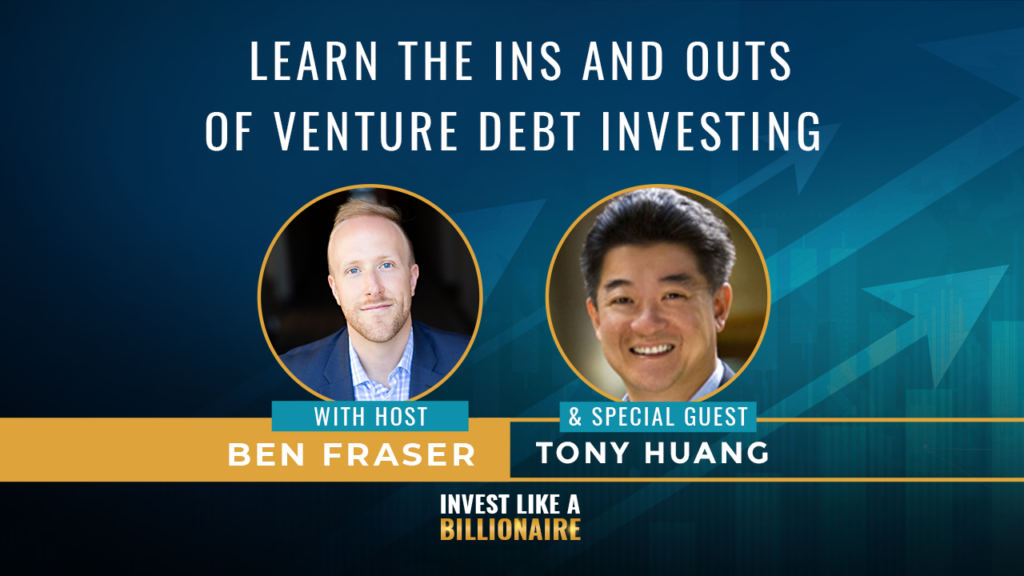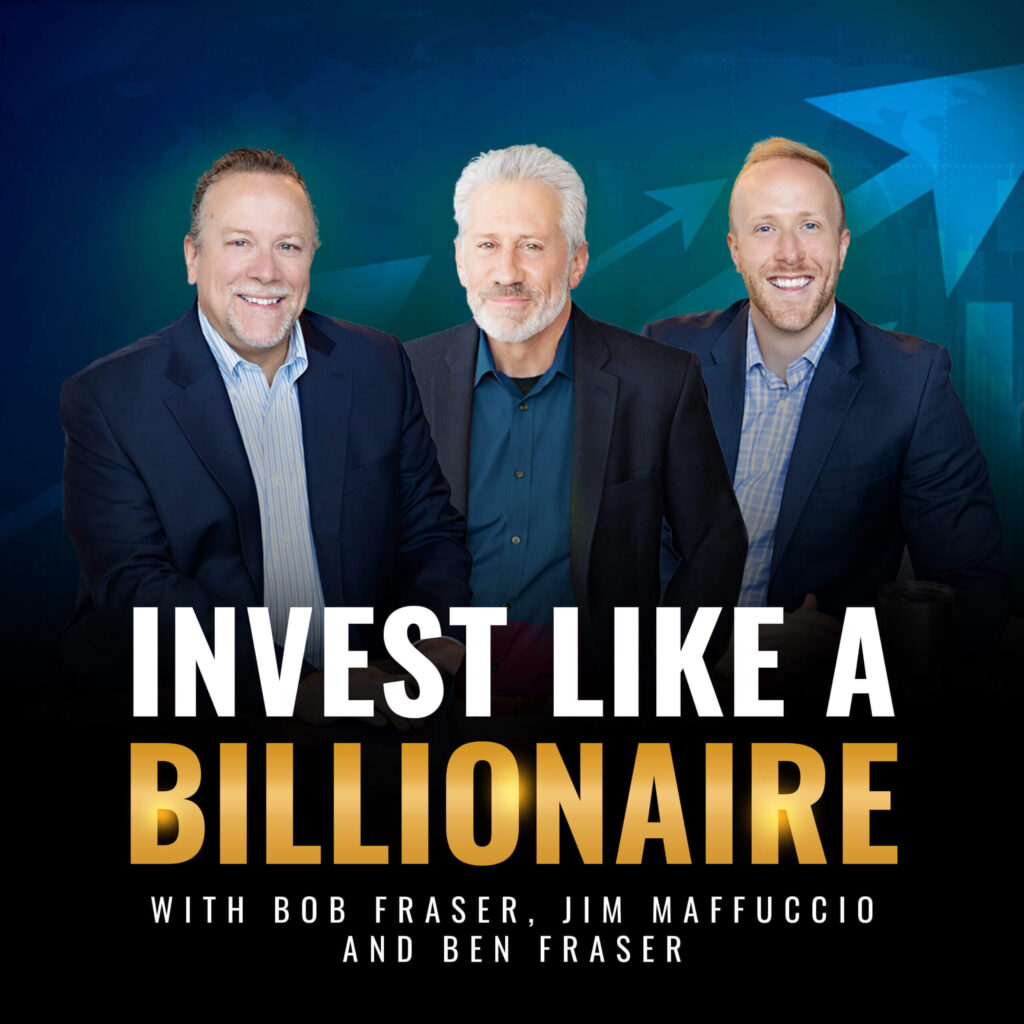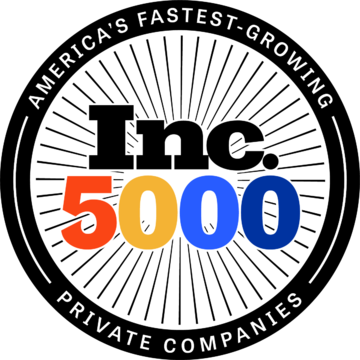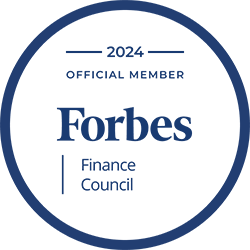You’ve heard about the venture capital firms that had success investing early in a company that has now made it big. What you don’t always hear is the number of investments that didn’t work out. It’s inherent to the investing model. But, our guest today, Tony Huang, founder of KISO Capital, has a unique strategy of lending to startups. Throughout his and his partners’ careers, they lent over $1BN in capital without a single loss. This strategy is called venture debt. Listen in to learn all the ins and outs of this investing strategy – how they achieve equity-like returns, with debt-like risk, how these loans benefit the business owners, and how one of his partners turned a $250K loan into a $58MM profit.
—
Watch the episode here:
Listen to the podcast here:
Learn The Ins And Outs Of Venture Debt Investing – Interview With Tony Huang
We’re excited to show this episode with you wanting to give you a sneak peek at what you’re about to read. We interviewed Tony Huang of KISO Capital about the cool stuff they’re doing over there and an amazing model. A lot of you guys are probably familiar with investing in real estate, maybe doing some single pay rentals on the side. You’ve heard about venture capital, but it just sounds too out there, too risky. What they do is focus on venture debt. They lend to startups, but their first position, senior secure, and the model they’ve created for investors is cool. You’re going to love reading about how they look at the deals, how they find these deals, and how over $1 billion in funded capital to startups, they’ve not lost a single dime.
This is something you’re going to want to tune in on because investors do not do enough debt. Debt is a great structure. Is it possible to have equity-like returns with debt-like risk? The answer is to tune in.
This episode is going to be exciting. We are joined by our guest, Tony Huang. He is with KISO Capital. He’s going to be talking about something very interesting that our readers are going to appreciate. It’s venture debt, investing in companies through debt instruments. In prior episodes, we’ve talked about the world of alternative investments includes real estate, venture capital and private equity, and hedge funds. For a lot of investors that are newer to alternative investments, most people start with real estate. It’s probably one of the biggest areas of alternative investments. One that we are excited about and excited to bring on is to talk about the venture capital space.
One thing that stood out to me when we started talking and met each other was that you do this through a debt instrument. At Aspen Funds, where we would manage our funds, we are lenders to residential debt. We get the value, and it’s automatic. I get why that makes sense, and it’s a pretty cool tool. A quick background on Tony. Tony has been an investment professional for several years. He’s been an active and continuous participant in Silicon Valley and Asia Pacific Venture Capital. He has been working with entrepreneurs since 1995 as an investment professional, an angel investor, and an advisor prior to cofounding KISO Capital. He was a venture partner at WI Harper. He was a Vice President at NXT Capital. Before that, he started his career as a Director of International Venture Capital at Silicon Valley Bank. If you’ve not heard of that, it is the premier investment bank in Silicon Valley.
He’s been involved in $1 billion worth of debt and 1,000 different companies.
Know what you’re doing. You’ve been around the block for a long time. The cool, exciting thing at KISO is you’ve launched this new fund that you’re raising for, investing in startups through debt instruments. Tony, it’s a long intro, but thanks for coming on.
Before we hand it off to him, this is so interesting because most high-net-worth individuals start in stocks and bonds. You graduate a little bit to real estate and have not looked much beyond into hedge funds or private equity, or certainly venture capital, but everybody’s playing the equity space. You’re in the stock market, buying equity of companies in real estate, thinking equity, debt is massively underinvested. Especially what you guys are doing, there’s a lot of debt that has equity-like returns but debt-like risk. There are super smart, outsized, very good risk-return parameters. This is something that more investors need to be looking at, the debt space. Most people are under-invested in debt. I wanted to say that and set the context. This is a very important conversation in the big picture as this specific fund. With that, go ahead and tell us a bit little bit of your story and your journey, how you ended up here.
Thanks for having me. I’ve been in venture debt for all my career. I love talking about it. I’m a firm believer in it. I made it a career and a living out of it. I tend to ramble on, so stop me if I’m talking too much. I started my career with Silicon Valley Bank several years ago. I did not start as a director of an international VC group. I started at the bottom as an intern making $3.50 an hour in 1995. Intern, credit analyst, loan officer, then they start giving you a corporate title, ADP, VP, director. I cut my teeth in regular commercial lending. Silicon Valley Bank has grown into the twentieth-largest bank in the US. They also bank 50% of all the privately held venture-backed companies in the United States, 50% market share.
You had incredible exposure to some of the big names out there, movers and shakers.
They’ve been around for many years. They finance a lot of the household name big companies that used to be startups in a garage. That’s why I learned this business of how to profitably and safely lend money to a startup that is sometimes pre-revenue, but most of the time pre-profit, they’re still generating losses. How do you do that?
Most bankers won’t touch that. Traditional bankers don’t touch that stuff.

A lot of them tried, and most of them failed. SVB has had a lot of imitators over the years, but they’re still unquestionably the leading provider of capital to, they call it, innovation economy. That’s the tagline. They’re doing well. I’m fortunate to have started my career there. I’ve spent ten years there. After that, I was recruited to start a Silicon Valley office for another venture debt fund, grew that business and managed that portfolio for about four years, moved up the risk curve, and moved on to the equity side. At WI Harper, I was doing just pure equity venture investment. 1 of 1,000 VC funds in the United States actively in writing checks to seed and series stage companies both in Asia and the US. The timing was right. We started planning to launch our own venture debt fund, me and two other like-minded partners, and KISO was launched.
You’re fresh out of the gate. Congratulations on that. Before we get started, what is venture debt?
I love this asset class I’ve been involved with over a long time. Let me give you the history. Let’s take a snapshot and look at the broader picture. Everybody knows what venture capital is. There were 1,000 VCs. In 2020, there were $150 billion deployed. In 2021, about $200 billion was deployed just in the US, not globally. That’s the equity side. On the debt side, we’re talking about private debt. This means debt to privately held companies. We’re not talking about commercial paper, a public traded company, or deal with treasury or T-bills. It is debt to privately held companies for ones that fit the venture profile. Many of these companies are still mostly pre-profit. They’re still loss-making. In 2020, about $30 billion was deployed. In 2021, $50 billion.
In debt? This is lending to venture-backed companies?
That’s correct.
The first question is, these guys are venture-backed. Why would they need debt? Is there a demand for this?
Let me give you a simple illustration. You’re a startup. Let’s say you, Ben and Bob, started a company, created a business plan, and you went out and raised, trying to pitch a VC to invest in your company. The VC said, “I like it. I’ll value your company at $10 million. I’ll give you another $10 million.” Imagine that scenario. Before you raised the funding, you and Ben owned 100% of the company. After the fundraising, you now own 50% because your investor owned the other 50%. Pre-money is $10 million. You raised $10 million. Your money is $20 million. Imagine a different scenario. You raise $5 million of VC money. You borrow another $5 million. Send $10 million to use that hasn’t changed. Your pre-money valuation doesn’t change at $10 million, but now your post-money is only $15 million because you raised $5 million out of $10 million.
I own 75% of my business.
You’ve got it, minimizing dilution. You can build a billion-dollar business. One is 50% dilution. The other one is 30% dilution. Which one would you take?
There’s a real appeal to venture capitalized companies to not just take all equity and give up their ownership. Especially if they’ve got a legitimate moonshot here, they want to keep as much ownership as they can.
That’s precisely the point. To follow up on that, as you know, VCs don’t typically give you all the money in one shot. They build it out in trenches to see the company progress. As a company makes progress, the evaluation goes up accordingly. Once you raise money at a higher valuation, it also minimizes the dilution. This is also for the VC as a way to control the risk by not giving you all the money in one shot, but rather in the trenches as they see progress. If you raise additional capital at a higher valuation, then that also minimizes dilution. Part of the value, the venture debt is to delay or buy more time. Delay your capital raise so that you can reach a higher critical milestone. Imagine you’re in the alpha stage, beta stage, first customer, expansion stage. Anytime you reach a critical milestone, your company becomes more valuable. You always want to delay your capital raise at a time.
The first principle of investing is to do not lose principle.
The earlier you raise money, the more expensive that money is going to be in terms of how much of your company you have to give up. That’s your point. You always want to wait and raise as little as you can and as late as you can. That’s a great point. Is there a lot of demand? I hear it’s a good strategy, but there’s a lot of companies that are very interested in doing this.
Yes, there is. This business has been around since the beginning of venture capital. It originally started as venture leasing. Remember, back in the days, you had on-premise equipment. There’s no cloud and no internet. A lot of the startup’s funding goes to buying computers, servers, and fixed assets, which isn’t a good use of equity dollars. It’s an expensive form of capital. That’s why venture leasing came into being because there’s equipment and collateral.
Even though they’re not that much in a distress sale, they’re worth pennies on the dollar. Some middle-market leasing firms decided that it’s worth the risk to do equipment leasing to these companies and take a small amount of warrants. That eventually morphed into what we call venture debt, meaning the money can be used to fund anything, for growth, marketing, hiring more people, not just for equipment. That’s the definition of venture debt. It got started in venture leasing many years ago.
It’s a growing space as well. You said last 2020, $30 billion deployed in venture debt, and in 2021, it’s $50 billion. Do you see that trend continuing to where there’s going to be more demand for this as entrepreneurs see the benefits?
The benefit is apparent. If you are an entrepreneur and you had an option of using debt completely to financial business, meaning there’s zero dilution that you own 100% of your company at the time of exit, that’s the ideal scenario, but that’s academic because then don’t typically take that kind of risk. That’s equity risk. My job is to evaluate whether I’m taking equity risk or debt risk. As a business, if I’m taking equity risk and only getting a debt-like return, I’m not going to have a successful business in the long run.
Let’s talk about the risk. Ben, you’re a commercial banker by background. You were a lender. You worked for some large banks in the region. This has got to be raising every red flag to you as a lender. You could never have underwritten a lot of the deals that he’s talking about.
Negative cashflow or pre-profit, that’s an automatic no.
No assets, except maybe computers that depreciate faster than a match burns out. How do you get around that?
Many people do it differently. They come in two flavors. You can imagine a startup with no business and no pre-revenue. They just raised a bunch of equity. They’re going to burn through it. Lenders, especially some of the banks, are going to track your remaining month of liquidity. They put covenants around them. They track how much cash they have. Different people have different comfort levels. They also have one common thing. They always look for venture-backed companies. VC provides the equity support, and then you layer on top of that some additional debts, but there is an implied comfort level. That’s betting on the jockey, not the horse. Tier one, VC backing or equity sponsorship or equity venture-backed, that’s the criteria for the majority of the venture.
The concept is that these big VCs will not let these guys go under because of a cashflow issue game. They got skin in the game, so they’re going to come to rescue the deal.
That’s the underlying, unspoken secret. That’s the assumption. The lenders are very aware of that. They’ll speak to the equity sponsor, understand the investment thesis, why they remain supportive and gauge whether the equity guy is likely to continue to support the company. As you can imagine, once the company has started getting into the 15th or 20th year and the VCs are tired, that’s when you see a lot of these companies where the investors have given up. The company is on its own. If you’re getting involved in that situation, you need to be very aware that there’s not much equity support behind the company. That’s predominantly how venture lenders think and act. There has to be quality venture capital support, and then couple that with deal structure, putting covenants around your balance sheet, minimum tangible net worth, minimum cash.

You can use the facility if I have to live with the financial covenants. Why we started KISO is realizing that, in reality, owning 0.5% of all startup-raised VC money, the other 99.5% of startups out there that are bootstrapped are doing very well. You had an example. Mailchimp, an email marketing company, was bought for $12 billion. That company was completely bootstrapped and never raised outside funding. It’s the largest ever bootstrapped company exit in history. That’s one extreme example.
At least that’s what the KISO’s founding pieces are. I’m willing to bet that other than 99.5% of non-venture-backed companies, a lot of them are on a path to become the next Mailchimp. That’s what we focus on. While our peers focusing on the venture-backed stuff and they’re beating each other over the head, and it’s a race to the bottom by offering cheap debt, I’d rather keep my economics and focus on the best companies that are bootstrapped. It’s not to say that we won’t work with a venture-backed company. It’s just that the competitive nature of the market is that you’ve got a tier-one VC-backed company, and you know who those are, the household names on Sand Hill Road.
You have a lot of venture lenders offering their portfolio companies cheap debt. That’s not the market that we want to fit in. We started KISO. KISO means foundation in Japanese. My co-founder picked that name. Neither of us is Japanese. We liked that theme. We focus on the business fundamentals, your basic business model and unit economics. I want to make sure there’s product-market fit because, in lieu of venture backing, I have to stay 100% focused on the companies’ business fundamentals that we provide capital to make sure there is a path to profitability. That’s how we underwrite.
That’s your secret sauce. The way you manage your risk is by investing in these kinds of companies. Do you also get warrants? Explain how warrants work and how those can be a part of the equation here.
A typical venture debt is you take the money upfront, and you can use it however you want. It typically amortizes over 3 to 4 years. Most of the time, to give the company some reprieve so they can use more of the dollar longer, we would provide an interest-only period upfront. Let’s say for the first six months, you only pay interest on the outstanding principal. After the initial six months, the principal needs to start amortizing. At the end of the term, the principal should be zero. Think of it as a smaller, shorter term mortgage. Interest typically is low to mid-teens. There’s no financial covenant. There’s no personal guarantee. We are a senior secured creditor in that we file the first position, use a lien on a company, including all assets and IP. The interest rate in the low to mid-teens is only for a true venture lender. That is only half of the expected economics. I’m counting on the warrant or put an option in a company.
A warrant is an option to purchase stock in the company at a fixed price taken at the company’s current valuation. If the company is valued at a $20 million valuation, then the per-share price that translates to the valuation will be the out-exercise price. Typically, the rights are exercisable for ten years. Within the next ten years, we have the right to buy into the company and exercise that option. Venture lenders don’t exercise options and just hold onto the stock. We only exercise our option or warrant when there’s a liquidity event, M&A or IPO. It will be an instantaneous exercise and a liquidation scenario.
To paint a picture for our readers, you’ve heard about the Facebook employee that got stock options. As a lender, you’re getting stock options. You’re playing a little bit in the upside of this company as well.
That’s very important. Warren Buffet said, the first rule of investing, don’t lose the principal. We are senior secured creditors. I’ve never lost a dime of principal on the venture debt. Not all companies make it, but there’s a way out because you’re a senior secured creditor. The investor will buy you out, or even in a liquidation scenario because we’re top of the stack, there’s senior secured or unsecured creditor and then prefer and uncommon.
There is a pecking order, and we’re on the very top of that pecking order. Through covenants and structure, we get out of the position in a distress scenario. Number one is to protect the principal. Second, we make a very attractive current yield, especially in the current low-interest-rate environment. Where else are you going to get low to mid-teens in yield, cash-on-cash IRR? The third component is equity participation. Venture guys swing for the fences, equity guys. The other statistic I wanted to remind the readers is that 90% of all VC funds cannot return capital equity funds.
Ninety percent of venture funds don’t return the original investment to the investors.
They’re fighting an uphill battle. Think about it. If you charge a 2% management fee per year, and the fund is 10 years, you already spent 20% of the fund. You only get to invest 80% of the funds’ money, but you have to make back 100% of the fund’s principal. Fifty percent of all the VC funds cannot do that. The other 45% makes some money, but barely enough to cover the management fee that they spent. As a result, they only returned capital back to the investors. Imagine you invest in a venture equity fund, and ten years later, get only your money back. That’s not a very good return, but only 5% to 10% generate a positive return and carry interest.
The more homework you do, the more underwriting you do.
This is why the debt side is so much more attractive because you’re going to generally make money even when other people don’t. My unique history, I had a tech startup. I raised $44 million in venture capital. It was one of the largest venture-capitalized deals in the Midwest region of the United States in the late ‘90s. It’s super fast-growing, but there was the dot-com crash in 2001. You were there. You were probably at Silicon Valley Bank at that time. Is your fund going to get wiped out in a scenario like that? If that thing happens, is this a complete wipeout in a truly nuclear scenario, where the equity just disappears, these companies can’t follow on funding, and other things evaporate?
I don’t think that kind of a doomsday scenario is likely. At least I’ve been through 25 years in income through probably 3 or 4 up and down cycles. Dot-com is one of them. The financial crisis is another one. In fact, the best companies are probably founded during that time. I’ve also been on the equity side. I sat on a board of a startup where we wrote the valuation from $5 million to $500 million and was counting on realized gains. Instead, the company burned through $200 million and went to zero.
It was a wild ride. It made me focus on the company’s fundamentals. What value do they provide to the market? Who’s going to pay you for your product and services? That is more important than anything else. When you talk about venture return, it could be very elusive. Most VCs talk about their IRR but that’s unrealized. It’s projected. Some people call it pro forma or projected, whatever creative name they call it.
The only thing that matters is cash-on-cash IRR, what their LPs put in and what they got back. In other words, DPI, Distributed Value to Paid-In Capital. You’d be surprised how little equity VCs are willing to disclose what their DPIs are, just because there’s nothing to write home about. That’s the nature of the game. You hear about the home runs that the VC invested in Google and Facebook, and they make 1,000 X return. Those exist.
It’s less than 5% of all VC that can do that. As a capital provider, we want to be on the other side. Banks are too conservative. Equity guys, the variance is too high. You have a 95% chance of losing all your capital, but that’s why we’re in a venture debt business. We protect our principal. We generate a high current income, and I still have the warrants. For some venture lenders, especially the banks, the warrant is an afterthought. It’s nice to have. They get the warrant. It doesn’t cost them anything if they happen to materialize quickly. If not, no harm, no foul. For true venture lenders like ourselves, we think and act like an investor, but we choose to report our capital in the form of debt. I’m willing to give out some upside in order to protect the downside.
Pay a lot of attention to the warrant.
The warrant is huge for us. In the history of venture debt, my partner had a distinct honor of having done that deal. I won’t disclose the name of the company or the fund that did it, but it was a $250,000 three months bridge loan in the form of venture debt. This is a pre-dot-com era. That $250,000 loan after 90 days got repaid plus interest, plus a warrant. The warrant realized $58 million in warranty.
You’ve lent $250,000 and you’ve got $58 million in the warrant.
The point I’m trying to emphasize is that it’s not even an equity investment. It’s a debt.
It’s a super safe, three-month investment. Tony, I’m loving your thesis. I haven’t gone through the dot-com crash. You see equity valuations crash. That doesn’t mean the businesses crash. For example, let’s take Facebook or Amazon. Mailchimp is a great example. Mailchimp has probably hundreds of thousands of customers that pay a monthly fee to have access to manage their mailing lists. If the equity market crashes, meaning the value of those companies in the public sense crashes, it doesn’t mean their business went away.
Facebook, it doesn’t mean people are going to stop wanting to advertise on Facebook or stop buying from Amazon. Even if Amazon’s price crashes from whatever it is hundreds of dollars to $1 a share and the market’s valuing them as worthless, but as long as they’re producing revenues, it doesn’t matter. You’re underwriting the business as a good business that you would perhaps make an equity investment in, but instead of making an equity investment, you’re then making a debt investment to enhance your safety. I love this business model.

What I love to dive into a little bit is the underwriting side of it. When I hear you say you’ve not lost a dime of principal, that’s incredible. We all know the stats of startups failures, where it’s 30% go under in the first year, it’s another 30% in the next three years. You probably know those stats are better than I do, but the failure rate is very high. How do you mitigate the risks? A lot of times, there’s not a lot of good collateral, especially tech-based businesses. A lot of times, they’re pre-profit. The flags of risk are high, but your track record says otherwise, so what are you doing? What is the secret sauce? As much as you can, share what you’re doing and your history of finding the right jockeys to lend to.
I wish there was a more formulaic way of explaining it. This is input-output. In reality, it’s not. This is more of an art than a science. If you look at Silicon Valley Bank and other PDCs, business development companies like Hercules, Triple Point, or Horizon. They’re published. These are public traded companies. Look at Silicon Valley Bank. They’ve been published with a company for 35-plus years. Look at their loan loss rate every year for the past several years. This has never come above 2% during any financial crisis or dot-com bubble burst. A commercial bank is still regulated as a commercial bank.
They have the answer to the Fed. They have a more conservative underwriting process. Even to venture debt funds, it is expected to lose some principal. In my experience, a true venture debt fund should operate at less than 1% lifetime loss rate type of ratio. I haven’t lost any principal, maybe just lucky or I’m due eventually. I don’t know. The more homework and underwriting you do, and try to minimize that unexpected outcome, I can’t emphasize that enough. You pick the right companies and management team. You structure the deal correctly. You build a granular portfolio. I’m not going to put all my funds in one basket.
The objective is to spread the fund across 30, 40 companies to build a very diversified portfolio, protect the principal, generate current income, keep accumulating this massive portfolio of warrants that hopefully eventually will materialize. Some could be like the case I mentioned, $250,000 into warrants. That’s not even a convertible loan. It is a loan plus interest plus warrant, generating $58 million. Those potential exists, but protecting our downside is key to what we do. It’s based on our collective experience of over $1 billion deployed over 1,000 companies. I don’t know if there’s a right way to describe how we do it. It is part of your traditional credit underwriting, discipline, combined with how venture equity guys look at it, evaluate a startup. You put that all into one investment approach.
You’re naturally mitigating risks, too, with a shorter term. You’re amortizing these loans very quickly. You’re already getting the interest, which is your yield, but then you’re reducing your capital at risk in that company every month because you’re getting a principal back.
We’ve been focusing on companies that are bootstrapped means they have a strong revenue. They may be having some losses, but there are huge revenues. Anything that’s bootstrapped is going to have a fair amount of profit in there as well. Let’s shift to the fund. I want to talk about the fund. You’ve just got this started. Give us the particulars of the fund and how the funnel works, and what your parameters are.
My peers and all my competitors structure ourselves similar to how a VC fund would. It’s a limited partnership. Typically, ten years in tenure. At the end of tenure, the fund dissolves and they go out and raise subsequent funds. They raise subsequent funds at the end of 10 years, but more like 3 to 5 years. Once you deploy most of your capital, then you have no more dry powder, then you go on, you raise your fund 2, fund 3. You keep managing the existing portfolio from prior funds. That’s how venture equity and most venture debt funds work.
Ourselves, we’re also a private limited partnership. I’m the general partner. My investors are limited partners, except our partnership doesn’t have a definite fund life. We keep going perpetually because we have cashflow coming in. We will make a distribution to our limited partners every quarter. Only six months into the business, I’ve already made a distribution. Our first restriction to our limited partners based on interest income and fee income that we generate, that’s profit. We continue to recycle that partial principal repayment. That is our fund structure.
It’s an open-ended fund, right?
That’s the evergreen part of it.
I can put money in at any point, and I can presumably have some liquidity.
It will be difficult to do a venture debt business and make a name for yourself if you haven’t been around in this game for a while.
You have liquidity every quarter. If we do our job right, there’s no long default. We calculate our net asset value of the fund every quarter. As long as we’re above water, there’s additional interest. We have casual coming in. We make a quarterly distribution to our LPs. Our limited partners can redeem their position, like redemption or a hedge fund. They can get out anytime they want. If they’re not happy with the low teens cash-on-cash return that we’re generating for them, we’re happy to redeem their position out. They can take their money elsewhere. If they’re happy or other investors find our assets are attractive and our investment approach makes sense, they can invest in our fund anytime based on our net asset value.
What’s the yield you’re paying?
It’s not fixed. I’ve done three deals. One is 12.5%, one is 15%, and the other is 16%. We have two TMCs out that are all about between that low to mid-teens range. That’s the gross yield, but you have to minus the 20% carrier interest and the 2% management fee per year that we charge. Your cash-on-cash should be somewhere in the high single-digit to the low teens. That’s just the interest portion because it will take time for the warrant to materialize. If I take warrants in the company, I cannot expect the company to be bought six months or even a year from now. It might take a couple of years for that to materialize. That was a steady-state. We have modeled out the performance of the fund. My goal is to generate 20% plus cash-on-cash IRR.
You answered my next question, which is the fee. You charge 2% of assets under management per year and 20% of the profits above the previous quarter NAF. The investors get the rest. The fund is fully deployed, then there should be mid-teens or low-teens yields on this.
That’s my experience from having managed and being involved with multiple debt funds through multiple cycles that yield in this market even though we’re in an all-time low interest rate environment. True venture debt. That’s the one that doesn’t have covenants attached to it. It doesn’t have a personal guarantee attached to it. It is still commending low to mid-teens in coupon. The market for that has held up evenly for the past several years, despite all the different interest rate environments or the equity market situation that we’re in. I am confident that we can achieve that. That’s cash-on-cash. You hit the nail on the head. It’s not a good way to categorize it, but that’s the reality. Let’s say we do a three-year loan. If the company survives at least three years, we’ve got all our money back.
You’ve made money.
You’ve collected the warrant. Do you usually include the warrant in your NAV calculation when you try and value that warrant?
Yes, we do. That’s the biggest fluctuation in the NAV calculation, the warrant portfolio, because of the interest and the loan.
The private equity market’s biggest challenge most times when investors are investing is liquidity. You don’t see a lot of open-end fund structures in the private equity markets, especially in the venture, because these are long of times
Ten years. Your money’s locked up.
To me, as an investor, that is a huge benefit.

One of the reasons people go to the public markets is to get liquidity, but you ended up paying for liquidity with the volatility. We run an open-ended fund. Our income fund is open, and it’s the same thing. It’s NAV-based. We have a massive amount of liquidity from loans that are being paid off quarterly, so it’s exactly the same concept. You’ve got loans maturing all the time. Managing investor liquidity, you can’t make guarantees, but there’s strong liquidity, organic liquidity that you can satisfy your investors’ needs. It is a very good concept.
We have a lot of investors that also are active in real estate. They understand the senior secure portion, the underlying collateral, and there’s a current yield. We just add on top of that, the equity upside.
Talk a little bit about deal flow because I would imagine if 95% of these venture capital funds are barely returning capital back to investors after it’s all said and done. Getting good deal flow is the critical factor here in finding the right jockey. You’ve been in this space for decades. I would imagine that that’s part of that. How do you guys go out and find these companies and find the bootstrapped ones that aren’t even necessarily looking for venture capital and may not know about this and how do you find them?
Luckily, we have other peers like Silicon Valley Bank and all the other guys that have been advocating this business model. With the advent of FinTech, I’m sure you heard of revenue-based financing or MRR, Monthly Recurring Revenue, SaaS model type of financing, which has mushroomed over the last few years. If you’re developing a SaaS enterprise, the startup’s founders are pretty savvy these days, knowing that there are a lot of nonequity, non-diluted forms of debt financing out there. I consider revenue-based financing is predominantly that instrument, even though technically it may not be defined as a classic in the classic sense, but it’s giving you along on your upfront payment, on the future receipt of your revenue.
There are a lot of innovations, and these are all happening very fast, but we are still more of a traditional way. I want to meet the entrepreneur, at least see them face to face. I go visit their facility, understand what it is that they do, do customer reference calls. It’s not a number or a formula for me. It’s not based on calculating your gross merchandise value and how much of your revenue I can lend you. There are a lot of people that build a profitable business like that, but that’s not our model. In terms of deal flow, most of my peers are focusing on venture-backed stuff. They have a defined channel. They go to all these VCs and solicit deal flow from them.
That’s all they do. In fact, that was my role in Silicon Valley Bank. We have 30-some people that do nothing but call on the VCs. We’re dedicated venture liaison people. That’s why they cornered this market. They figured where to get the best deal flow. On the bootstrap side, it’s based on a pure personal network. It’ll be difficult to do this business and make a name for yourself if you haven’t been around for a while. Our personal network, our personal brand, me and my partner having been in this business, each of us between 25 to 30 years, we have a proprietary source of referral sources, both intermediaries, commercial banks, other venture debt funds. Remember, I talked about a lot of debt funds that are now focusing on the top market.
They’re going after those big unicorns. They’re not going to waste time doing deals that are sub-$5 million or sub-$3 million, but that’s perfect for us. We’re on the receiving end. We have been on the receiving end for a lot of these good-quality referrals. It’s vice versa. Our business is all based on mutual referral. It’s not a direct-to-consumer business. We don’t market ourselves actively in the marketplace. It’s all through proprietary deal flow through our own network.
What’s your minimum investment into the fund as an LP investor?
It’s tiny because we want to make it LP-friendly. It’s $100,000, but as you know, as a GP, we have discretion. I’m not making money on the management fee. This is not about AUM, Assets Under Management. I will demonstrate our model through actual results. The result comes in the first or second quarter that you’re in. We have a one-year lockup clause. I’m asking my LPs, “Give me one year to use your money to demonstrate our model. At the end of the year, if you’re not happy with the low teens return and the potential that we have generated on the warrants, then take your money out.” I’m doing my job right. I’m hoping that our investors will be willing to give me more of their money. That’s why we’re willing to take a small check because I want to earn their business down the road in the form of additional commitments into the fund.
Building a long-term relationship and improving the value. That makes a lot of sense. Tony, for investors, if they’re interested in learning more about what you guys are doing, what’s the best way for them to get ahold of you or find out about your firm?
Our website is KISOCapital.com. I designed it. It’s pretty plain, but we’re not a direct consumer marketing firm. That’s the best way to reach out to me. I keep a very active profile on LinkedIn. I was one of the first guys that the founder of LinkedIn pitched to. The CTO of LinkedIn was my first LinkedIn connection. I was a very early adopter of LinkedIn. I pass on them, unfortunately. Reach out to me on social media. Google KISO Capital, our website.

My LinkedIn profile is pretty comprehensive. Reach out to us. I’d love to hear from you. From a deal perspective, partnership perspective at any time, just like what we’re doing now. I love talking about this asset class. It’s a win-win situation. We’re not selling anything. Our money helps the entrepreneur minimize dilution, grow their business. We’re generating above-market risk-adjusted return from our LPs and making a profit for ourselves. There’s nothing else I’d rather be doing.
Thank you so much for joining us. This is educational. I learned a lot. It’s very cool what you’re doing. Thanks for coming on.
I love the models and what you’re doing. It’s great to meet you.
It’s a pleasure being on here. Thanks for the opportunity to share with the readers a little bit about the venture debt marketplace and what we do.
Thanks, Tony.
Important Links:
LinkedIn -Tony Huang
About Tony Huang
An international venture investments and business development professional for 25 years, Tony has been an active and continuous participant in Silicon Valley and Asia Pacific venture capital and entrepreneurial ecosystems since 1995 as an investment professional, angel investors, and a trusted advisor.
Prior to co-founding KISO Capital, Tony was a venture partner at WI Harper, Vice President at NXT Capital, and Director of International Venture Capital at Silicon Valley Bank.










